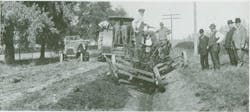The precise origin of the pull grader has been lost to history. The first graders were simply dragged along the ground, and the first wheeled pull graders consisted of a fixed blade attached to the frame of a wagon. These blades could be raised or lowered by levers, but not angled, and the wheels were rigidly attached to the vehicle’s frame. If the blade encountered a heavy load, the blade tended to slide away. The ability to angle the blade helped alleviate the problem but could not eliminate it.
In 1885, J.D. Adams developed the leaning-wheel grader. The leaning wheel, combined with an angled blade, increased the grader’s ability to excavate and move material in a specific direction. Adams sales literature explained the principle in the early 1900s:
“In considering the working principle of a grader, it is necessary to realize first that a grader’s work is to move earth sideways and usually uphill. Thus, the load is a side-load.
“The man pushing the wheelbarrow leans toward and balances his weight against the load, because that is the natural way to move it with the least effort.
“That is the principle on which Adams Graders operate. They have Adjustable Leaning Wheels [that] the operator can lean in either direction to lean the weight of the grader toward and balance the weight against the side load of earth on the blade—the heavier the load, the more the operator leans the wheels and weight of the machine.”
The idea proved enormously successful. Heinz-Herbert Kohrs writes in “500 Years of Earthmoving” that Adams was a road inspector when he had his idea, and that the idea turned the grader into an earthmoving machine. In his 1951 book, “Tools of the Earthmovers Yesterday and Today,” J.L. Allhands states that since Adams lacked the means to manufacture the grader, he worked as a traveling salesman after hiring a manufacturer to produce machines that he sold to local government agencies. Allhands also states that he had his own factory in Indianapolis by 1897.
Although leaning wheels were eventually offered by most manufacturers, there was at least one exception. C.D. Edwards Manufacturing proclaimed in bold type in a circa 1924 catalog, “Edwards graders are built with rigid wheels.” Edwards claimed that leaning wheels were needed only to correct for imbalanced design, and that the perfect balance of their graders held them against the load. Edwards went so far as to say that the perfectly balanced straight-wheel grader was “the greatest development and stride forward over the adjustable wheel.” Almost a century later, Adams’ principle lives on.
The Historical Construction Equipment Association (HCEA) is a 501(c)3 nonprofit organization dedicated to preserving the history of the construction, dredging and surface mining equipment industries. With more than 4,000 members in 25 countries, activities include operation of National Construction Equipment Museum and archives in Bowling Green, Ohio; publication of a quarterly magazine, Equipment Echoes, from which this text is adapted, and hosting an annual working exhibition of restored construction equipment. Individual memberships are $30 within the U.S. and Canada, and $40 elsewhere. Information is available at www.hcea.net, 419.352.5616, or [email protected].
About the Author
Tom Berry
Tom Berry is archivist for the Historical Construction Equipment Association (HCEA). Information is available at www.hcea. net, or by calling 419.352.5616 or e-mailing [email protected].
